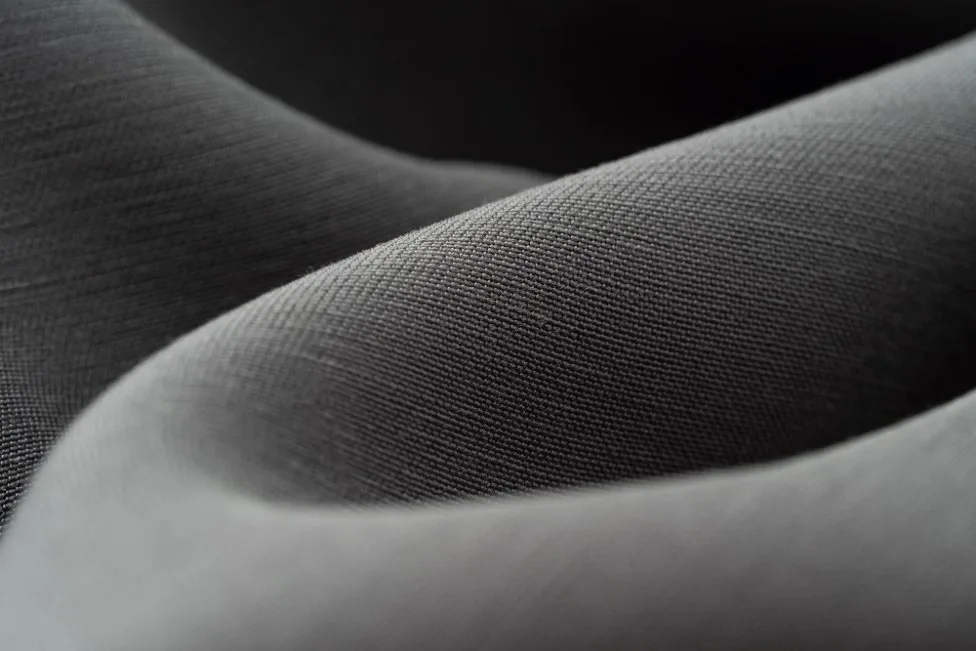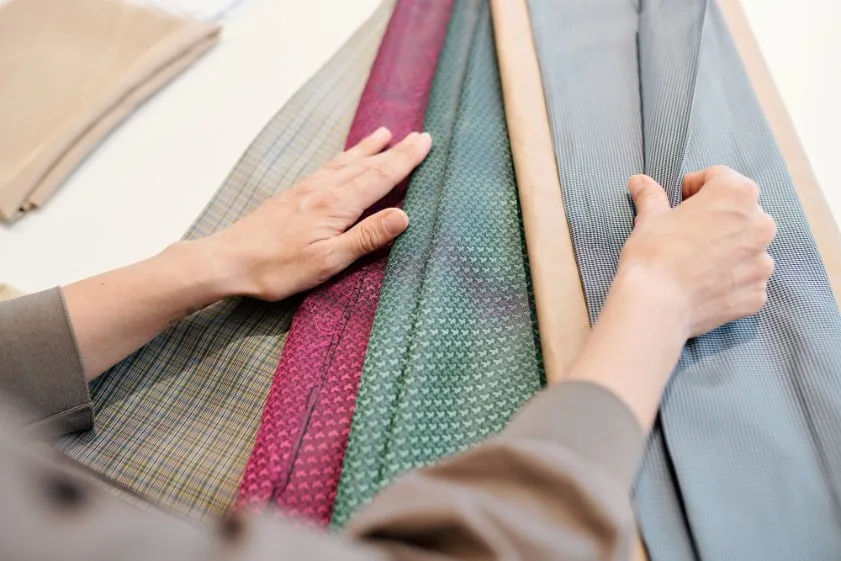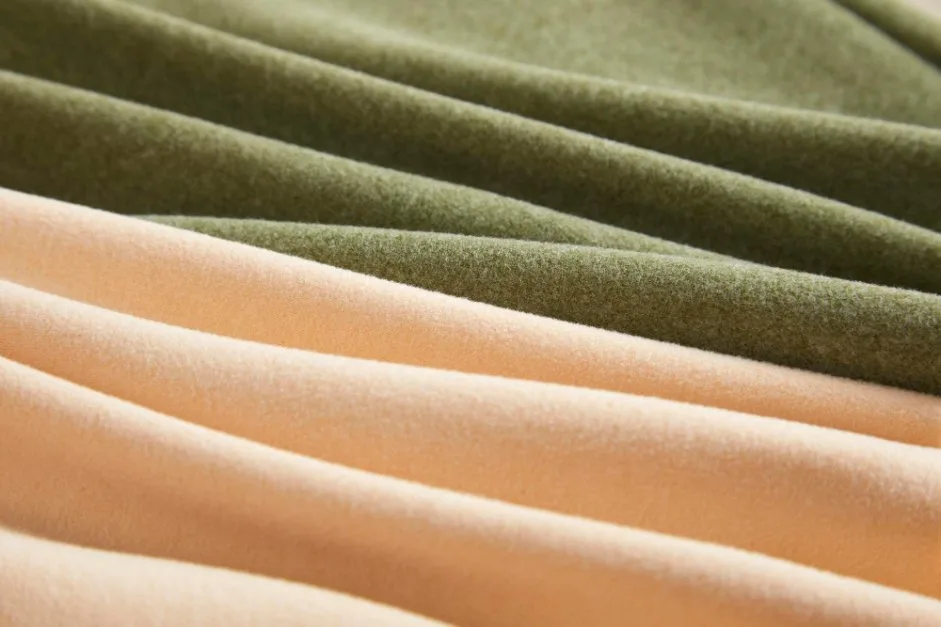Polyester Fabric Explained: A Complete Guide to Types, Uses, and Sustainable Practices
Polyester fabric stands as one of the most versatile and widely used synthetic materials in today’s textile industry. This durable synthetic fiber has revolutionized clothing production, home furnishings, and industrial applications since its commercial introduction in the 1950s. Made by combining chemicals like ethylene glycol and terephthalic acid, polyester creates fibers that can be woven or knitted into countless textile applications.
The global polyester fiber market reached $109.57 billion in 2025 and is projected to grow to $157.38 billion by 2030, representing a 7.5% compound annual growth rate. This remarkable growth reflects polyester’s continued dominance in the textile industry, where it accounts for over 57% of global fiber production.
People gravitate toward polyester because it dries quickly, maintains its shape exceptionally well, and typically costs less than natural fabrics. Many appreciate its low maintenance requirements and impressive longevity in everyday use. Understanding polyester fabric properties helps both consumers and manufacturers make informed decisions about this ubiquitous material.
Table of Contents
Key Takeaways
- Polyester is a strong and versatile synthetic fabric with exceptional durability
- It offers many uses due to its resilience and easy care requirements
- Understanding its qualities helps when choosing fabrics for specific purposes
- Environmental considerations are increasingly important in polyester selection
- Quality grades vary significantly across different polyester types
What Is Polyester Fabric?
Polyester represents a category of synthetic fibers created through chemical processes using petroleum-based materials. This man-made fabric belongs to the polymer family, specifically composed of compounds within the ester functional group. The most common type, polyethylene terephthalate (PET), forms the backbone of most polyester textiles used in clothing, upholstery, and industrial applications.
The fabric’s popularity stems from its remarkable combination of strength, durability, and affordability. Unlike natural fibers that depend on agricultural processes, polyester production occurs in controlled manufacturing environments, allowing for consistent quality and properties. This synthetic nature enables manufacturers to engineer specific characteristics into the fabric, such as moisture-wicking capabilities, flame resistance, or enhanced softness.
Polyester fabric serves multiple industries beyond clothing. Industrial applications include automotive components, filtration systems, and construction materials. The textile’s versatility extends to home furnishings, where it appears in carpets, curtains, and upholstery. This widespread adoption reflects polyester’s ability to meet diverse performance requirements across various sectors.
Historical Development and Evolution
The story of polyester begins in 1926 when British chemist W.H. Carothers first synthesized what would become known as Terylene. Throughout the 1930s and 1940s, British scientists continued developing improved versions of this synthetic fiber. The breakthrough came in 1941 when British chemists J.R. Whinfield and J.T. Dickson created the first practical polyester fiber.
DuPont Corporation brought polyester technology to the United States and began mass production in 1951. The company marketed it under the brand name Dacron, which became synonymous with polyester fabric quality. During World War II, the Allied forces recognized polyester’s potential for military applications, particularly in parachutes and other critical equipment where reliability was paramount.
The 1970s marked polyester’s golden age in consumer fashion. It gained enormous popularity as an affordable alternative to natural fibers, especially for suiting and business attire. The decade saw polyester become a household name, though its association with cheaper clothing also began during this period. Modern polyester has evolved significantly from these early versions, with improved manufacturing techniques creating softer, more comfortable fabrics.
Polyester as a Synthetic Fiber
Polyester’s synthetic nature distinguishes it fundamentally from natural fibers like cotton, wool, or silk. The manufacturing process begins with petroleum-derived chemicals, primarily ethylene glycol and terephthalic acid. These raw materials undergo polymerization, creating long molecular chains called polymers that contain ester linkages throughout their structure.
The polymer creation process occurs at extremely high temperatures, typically around 280°C (536°F). Once formed, the molten polymer passes through spinnerets, which are essentially industrial versions of a showerhead with thousands of tiny holes. As the polymer emerges and cools, it solidifies into continuous filaments that can be further processed.
These filaments can be cut into staple fibers of various lengths or kept as continuous filament yarn. The choice depends on the intended application and desired fabric characteristics. Staple fibers create fabrics with a more cotton-like feel, while continuous filaments produce smoother, more lustrous textiles. This flexibility in processing allows manufacturers to tailor polyester properties for specific end uses.
What Is Polyester Fabric Made Of?
Polyester fabric originates from a chemical reaction between petroleum-derived compounds. The primary components include ethylene glycol, a clear, colorless liquid, and terephthalic acid, a white crystalline compound. When these materials combine under high heat and pressure, they form polyethylene terephthalate (PET), the most common type of polyester used in textiles.
The molecular structure of polyester consists of repeating ester groups linked together in long chains. These chains can be linear or branched, depending on the specific manufacturing process used. The ester linkages provide polyester with its characteristic strength and chemical resistance, while the polymer backbone contributes to the fabric’s dimensional stability.
Modern polyester production increasingly incorporates recycled materials. Recycled polyester, often called rPET, uses post-consumer plastic bottles and textile waste as feedstock. This process involves cleaning, shredding, and melting down plastic waste before reforming it into new polyester fibers. The chemical composition remains virtually identical to virgin polyester, but the environmental impact is significantly reduced.
Types and Grades of Polyester Fabrics
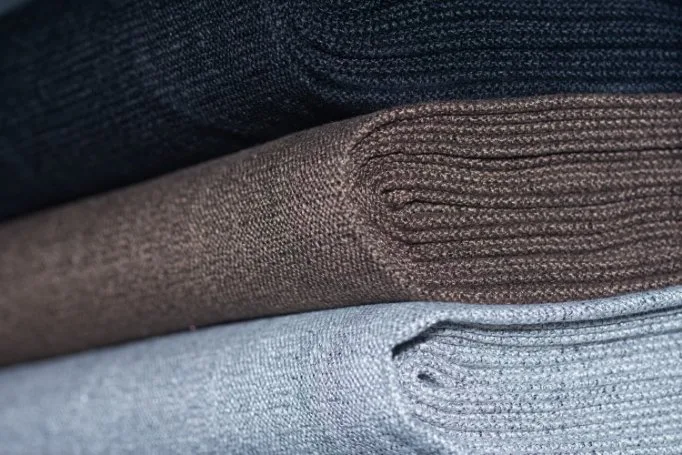
The polyester family encompasses numerous variations, each engineered for specific applications and performance requirements. Understanding these different types helps consumers and manufacturers select the most appropriate polyester for their needs. Quality levels range from basic commodity grades to high-performance specialty fibers with enhanced properties.
Primary Polyester Types
- PET (Polyethylene Terephthalate) represents the most widely produced polyester type, accounting for approximately 90% of global polyester fiber production. PET offers excellent strength, durability, and chemical resistance. It performs well in clothing applications and provides good color retention properties. Most everyday polyester clothing contains PET fibers due to their balanced performance characteristics and cost-effectiveness.
- PCDT (Poly-1,4-cyclohexylene-dimethylene terephthalate) delivers enhanced elasticity and resilience compared to standard PET. This polyester type exhibits superior shape retention and recovery properties, making it ideal for upholstery, carpets, and heavy-duty applications. PCDT polyester costs more than PET but justifies the premium through improved performance in demanding applications.
- Plant-Based Polyester represents an emerging category that uses renewable feedstocks instead of petroleum. Companies like NatureWorks produce bio-based polyester from corn-derived sugars. While chemically similar to traditional polyester, plant-based versions offer improved sustainability profiles and potential biodegradability under specific conditions.
Quality Grades and Classifications
Polyester quality varies significantly across different grades and manufacturing standards.
- Commercial Grade polyester provides basic performance characteristics at the lowest cost point. This grade typically appears in budget clothing, basic home textiles, and industrial applications where premium properties aren’t required.
- Premium Grade polyester undergoes additional processing steps to enhance softness, luster, and hand feel. These fibers often receive special treatments during manufacturing to improve their tactile properties. Premium polyester commands higher prices but offers superior comfort and appearance retention.
- Performance Grade polyester incorporates advanced engineering for specific applications. These fibers might include moisture-wicking properties for sportswear, flame resistance for protective clothing, or UV resistance for outdoor applications. Performance grades represent the highest quality tier and carry premium pricing.
Fabric Construction Variations
- Woven Polyester utilizes interlacing threads at right angles to create stable, strong fabrics. This construction method produces materials suitable for shirts, jackets, pants, and home furnishings. Woven polyester fabrics typically offer better dimensional stability and durability than knitted alternatives.
- Knitted Polyester employs interlocking loops to create stretchy, flexible fabrics. This construction appears primarily in t-shirts, sportswear, and activewear where freedom of movement is essential. Knitted polyester generally feels softer and more comfortable against the skin than woven versions.
- Microfiber Polyester consists of extremely fine fibers, typically less than one denier in thickness. These ultra-fine fibers create fabrics with silk-like softness and excellent draping properties. Microfiber polyester appears in high-end clothing, cleaning cloths, and luxury bedding applications.
| Polyester Type | Strength (PSI) | Elasticity | Primary Applications | Relative Cost |
|---|---|---|---|---|
| PET Standard | 50,000-60,000 | Low | Clothing, basic textiles | $ |
| PET Premium | 55,000-65,000 | Low-Medium | Quality apparel, linens | $$ |
| PCDT | 45,000-55,000 | High | Upholstery, carpets | $$$ |
| Microfiber | 40,000-50,000 | Medium | Luxury textiles, cleaning | $$$$ |
| Bio-based | 45,000-55,000 | Medium | Sustainable fashion | $$$ |
Key Properties of Polyester Fabric
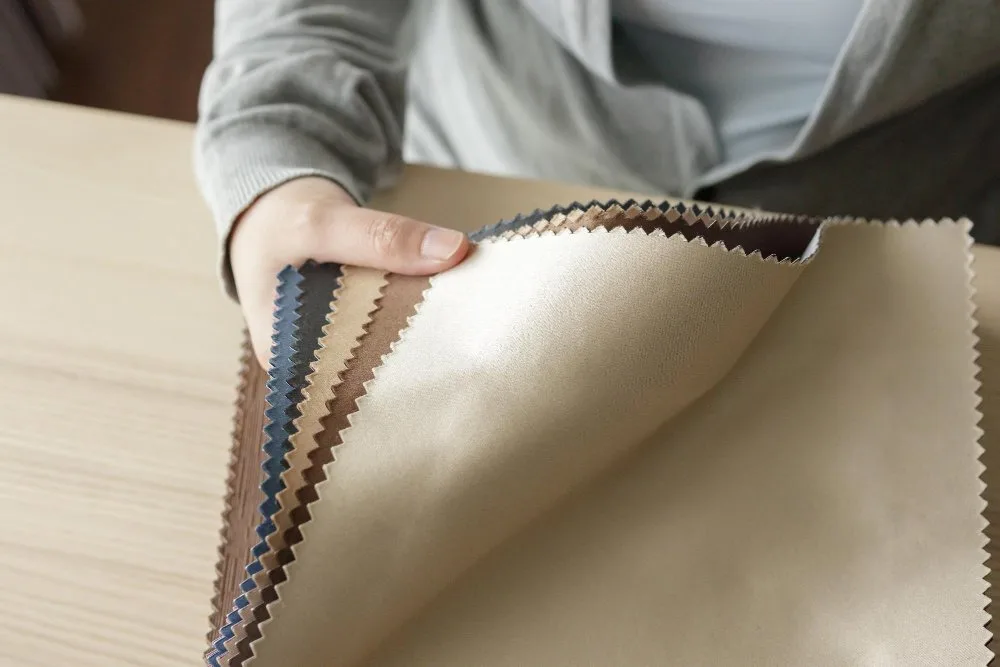
Polyester’s success stems from its exceptional combination of physical and chemical properties. These characteristics make it suitable for diverse applications while maintaining consistent performance across various conditions. Understanding these properties helps explain why polyester has become the world’s most widely used synthetic fiber.
Durability and Strength Characteristics
Polyester exhibits remarkable tensile strength, typically ranging from 45,000 to 65,000 PSI depending on the grade and construction. This strength surpasses most natural fibers and many synthetic alternatives. The polymer chains in polyester create strong intermolecular bonds that resist breaking under stress, making garments and textiles exceptionally durable.
Abrasion resistance represents another key strength characteristic. Polyester fibers withstand repeated rubbing and friction without significant degradation. This property explains why polyester clothing maintains its appearance after numerous wash cycles. Laboratory tests show polyester fabrics can endure over 50,000 abrasion cycles before showing noticeable wear, compared to 15,000-25,000 cycles for cotton.
The fiber’s chemical resistance contributes significantly to its durability. Polyester remains stable when exposed to most acids, alkalis, and organic solvents. This resistance prevents chemical degradation during cleaning and normal use. Mildew and bacterial growth cannot easily establish on polyester fibers, further extending fabric lifespan.
Wrinkle resistance stands out as a particularly valued property. Polyester’s molecular structure naturally resists permanent creasing, maintaining a smooth appearance without frequent ironing. This characteristic made polyester revolutionary in the fashion industry, offering consumers low-maintenance clothing options that retain their professional appearance throughout long days.
Dimensional Stability and Shape Retention
Polyester demonstrates exceptional dimensional stability, meaning it maintains its original size and shape even after repeated use and washing. This property results from the strong covalent bonds within the polymer structure and the fiber’s low moisture absorption. Unlike natural fibers that swell and contract with humidity changes, polyester remains remarkably stable.
Shape retention extends beyond basic dimensional stability to include drape and form maintenance. Garments made from polyester hold their silhouette throughout wear, preventing the sagging and stretching common with other materials. This characteristic makes polyester particularly valuable for structured clothing like suits, uniforms, and formal wear.
The fiber’s elastic recovery properties contribute to shape retention. When stretched, polyester fibers return to their original length once the stress is removed. This recovery typically exceeds 95% for quality polyester, compared to 75-85% for natural fibers. Such recovery prevents permanent deformation and maintains garment fit over time.
Temperature stability further enhances dimensional properties. Polyester maintains its shape across a wide temperature range, from freezing conditions to moderate heat. However, excessive heat above 200°C (392°F) can cause permanent deformation, requiring careful attention during cleaning and pressing.
Thermal Properties and Heat Sensitivity
Polyester’s melting point occurs around 250-260°C (482-500°F), significantly lower than natural fibers that char rather than melt. This characteristic requires careful temperature control during manufacturing, cleaning, and ironing processes. When polyester melts, it creates hard, potentially dangerous beads that can cause severe burns if in contact with skin.
Heat setting represents a valuable thermal property used in manufacturing. Polyester can be permanently shaped when heated to specific temperatures below its melting point. This process creates permanent pleats, creases, and textured surfaces that withstand repeated washing and wear. Heat setting also contributes to dimensional stability in finished garments.
The fabric’s thermal conductivity remains relatively low, providing moderate insulation properties. This characteristic makes polyester suitable for both summer and winter applications, depending on fabric construction and thickness. Lightweight polyester fabrics allow heat transfer for cooling effects, while heavier constructions provide warmth retention.
Static electricity generation increases with polyester use, particularly in dry conditions. The synthetic nature of polyester creates an imbalance of electrical charges during friction, leading to clingy behavior and attraction of lint and dust. This property can be managed through fabric treatments and proper care techniques.
Manufacturing and Production Process
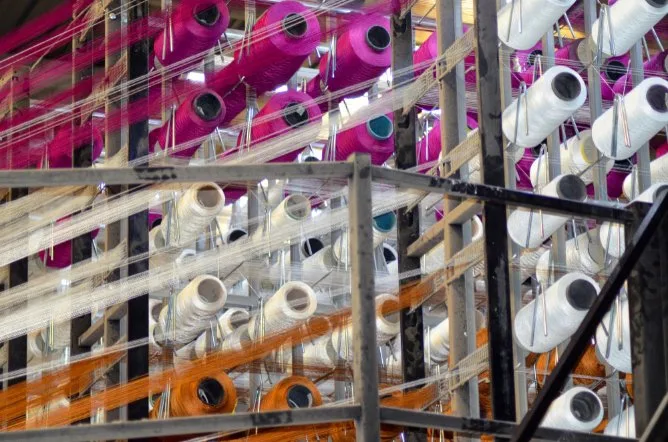
Polyester production involves sophisticated chemical and mechanical processes that transform petroleum-based raw materials into versatile textile fibers. The manufacturing sequence includes several critical stages, each affecting the final fabric’s properties and performance characteristics.
Raw Material Preparation and Polymerization
The polyester manufacturing process begins with the preparation of key chemical components. Ethylene glycol production typically starts with ethylene oxide, derived from petroleum cracking processes. This clear, viscous liquid serves as one of the two primary building blocks for polyester synthesis.
Terephthalic acid preparation involves oxidizing para-xylene, another petroleum derivative. This process creates white crystalline compounds that will form the backbone of the polyester polymer chain. The purity of both components critically affects the quality and properties of the resulting polyester fiber.
Polymerization occurs through a condensation reaction between ethylene glycol and terephthalic acid. The process takes place in large reactors at temperatures exceeding 280°C (536°F) and under controlled atmospheric conditions. During this reaction, water molecules are eliminated, creating long polymer chains with recurring ester linkages.
The molecular weight of the resulting polymer directly influences fiber properties. Higher molecular weights generally produce stronger, more durable fibers but may be more difficult to process. Manufacturers carefully control reaction conditions to achieve the desired molecular weight distribution for specific applications.
Fiber Formation and Spinning
Once polymerization is complete, the molten polymer must be converted into usable fibers through spinning processes. The polymer is maintained at carefully controlled temperatures to ensure proper flow characteristics while preventing degradation. Advanced spinning systems can process thousands of individual filaments simultaneously.
Melt Spinning represents the most common method for polyester fiber production. The molten polymer is forced through spinnerets containing hundreds or thousands of tiny holes, each creating an individual filament. The emerging polymer streams cool rapidly in a controlled atmosphere, solidifying into continuous fibers.
The spinning speed significantly affects fiber properties. Higher speeds create finer fibers with increased orientation, resulting in stronger materials. Typical spinning speeds range from 1,000 to 6,000 meters per minute, depending on the desired fiber characteristics and intended applications.
Drawing and Texturing processes follow initial spinning to develop final fiber properties. Drawing involves stretching the fibers under controlled conditions to align polymer chains and increase strength. Texturing creates crimp or bulk in the fibers, improving fabric hand feel and insulation properties.
Weaving and Knitting Methods
After fiber production, the material must be converted into usable fabrics through weaving or knitting processes. The choice between these methods depends on the intended application and desired fabric characteristics.
Woven Polyester Production utilizes traditional weaving techniques adapted for synthetic fibers. Warp yarns run lengthwise while weft yarns interlace perpendicular to create stable fabric structures. Common weave patterns include plain, twill, and satin, each producing different aesthetic and performance characteristics.
Modern weaving equipment can process polyester yarns at high speeds while maintaining consistent quality. Air-jet and rapier looms are particularly well-suited for polyester processing, offering precise yarn placement and minimal fiber damage during weaving.
Knitted Polyester Manufacturing creates fabrics through interlocking loops rather than interlacing threads. This construction method produces more flexible, stretchable fabrics ideal for activewear and casual clothing. Circular knitting machines can produce seamless tubular fabrics, while flat-bed machines create shaped garment pieces.
The knitting process parameters, including loop size, yarn tension, and machine speed, directly affect fabric properties. Tighter knitting creates denser, more stable fabrics, while looser constructions produce lighter, more flexible materials.
Quality Control and Testing
Modern polyester manufacturing incorporates comprehensive quality control measures throughout the production process. Chemical composition analysis ensures proper polymer formation and the absence of contaminants that could affect performance or safety.
Physical property testing evaluates key characteristics including tensile strength, elongation, and dimensional stability. These tests help manufacturers maintain consistent quality and identify any processing issues before products reach the market.
Color fastness testing is particularly important for dyed polyester fabrics. The synthetic nature of polyester requires specific dye types and processes, and testing ensures colors will not fade or bleed during normal use and cleaning.
Common Applications of Polyester Fabric
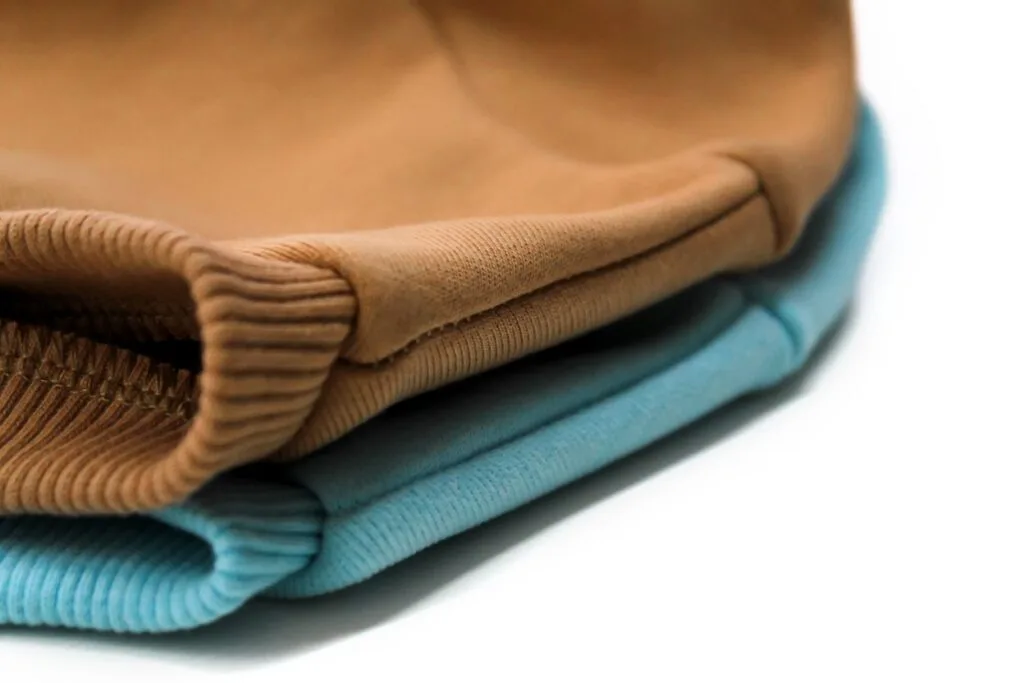
Polyester’s versatility and performance characteristics have made it indispensable across numerous industries and applications. From everyday clothing to specialized industrial uses, polyester continues expanding its presence in the global marketplace.
Clothing and Fashion Applications
Everyday Apparel represents polyester’s largest application segment. The fiber appears in shirts, pants, dresses, jackets, and countless other garments. Its wrinkle resistance makes it particularly valuable for business attire and travel clothing. Many manufacturers blend polyester with cotton to combine the comfort of natural fibers with polyester’s easy-care properties.
Sportswear and Activewear heavily utilize polyester’s moisture-wicking capabilities. The fiber’s ability to transport perspiration away from the skin while drying quickly makes it ideal for athletic applications. Modern athletic wear often features polyester with specialized treatments for enhanced performance, including antimicrobial finishes and UV protection.
The fashion industry increasingly embraces polyester for its design flexibility. The fiber can be engineered to mimic silk, cotton, wool, or create entirely unique textures. High-end fashion brands now use premium polyester grades that offer luxury aesthetics while maintaining the practical benefits of synthetic fibers.
Formal and Professional Wear benefits from polyester’s shape retention and durability. Suits, uniforms, and professional attire made with polyester maintain their appearance throughout long workdays. The fiber’s resistance to stretching and sagging ensures garments continue fitting properly over extended wear periods.
Home Textiles and Furnishings
- Bedding and Linens frequently incorporate polyester for its easy-care properties and affordability. Polyester sheets resist wrinkling and maintain their appearance after repeated washing. Many consumers appreciate the low-maintenance nature of polyester bedding, particularly in commercial applications like hotels and hospitals.
- Curtains and Drapery utilize polyester’s dimensional stability and fade resistance. The fiber maintains its shape and color when exposed to sunlight, making it ideal for window treatments. Fire-retardant treatments can be applied to polyester curtains for enhanced safety in commercial and residential applications.
- Upholstery Applications leverage polyester’s durability and stain resistance. Furniture fabrics often contain polyester to withstand daily use while maintaining their appearance. The fiber’s resistance to stretching prevents sagging and maintains furniture aesthetics over time.
- Carpeting and Rugs benefit from polyester’s resilience and stain resistance. Solution-dyed polyester carpets offer excellent color retention and soil resistance. The fiber’s ability to recover from compression helps maintain carpet appearance in high-traffic areas.
Industrial and Specialty Applications
- Automotive Textiles extensively use polyester for interior components. Seat fabrics, headliners, and trim materials benefit from polyester’s durability and resistance to fading. The automotive industry values polyester’s ability to maintain performance under extreme temperature variations and UV exposure.
- Filtration Systems rely on polyester’s chemical resistance and strength. Air filters, liquid filters, and industrial filtration media often contain polyester fibers. The material’s ability to withstand cleaning chemicals and maintain structural integrity makes it valuable for repeated-use applications.
- Geotextiles and Construction applications utilize polyester’s strength and durability. Road construction, erosion control, and drainage systems often incorporate polyester fabrics. The material’s resistance to soil chemicals and biological degradation ensures long-term performance in harsh environments.
- Medical and Healthcare applications increasingly use polyester for its hygienic properties. Surgical gowns, drapes, and other medical textiles benefit from polyester’s ability to withstand sterilization processes. The fiber’s low lint generation is particularly valuable in sterile environments.
Outdoor and Technical Applications
- Tents and Camping Gear utilize polyester’s weather resistance and durability. Modern camping equipment frequently features polyester fabrics with waterproof coatings. The material’s strength-to-weight ratio makes it ideal for portable equipment where durability cannot be compromised.
- Tarps and Protective Covers leverage polyester’s UV resistance and water repellency. Agricultural covers, equipment protection, and construction tarps often contain polyester. The material’s ability to withstand outdoor exposure while maintaining flexibility makes it valuable for temporary and permanent installations.
- Marine Applications benefit from polyester’s resistance to salt water and UV radiation. Boat covers, sails, and marine upholstery often feature polyester fabrics. The material’s dimensional stability prevents distortion from moisture changes, critical for marine environments.
Finishes and Treatments
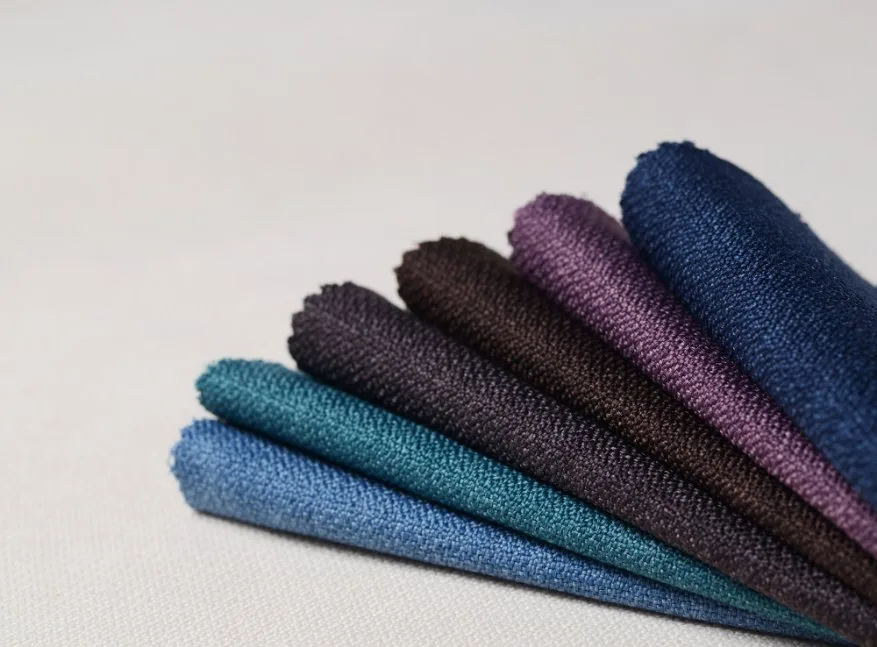
Modern polyester fabrics often receive specialized treatments to enhance their performance characteristics or adapt them for specific applications. These finishes can significantly improve functionality while maintaining the base advantages of polyester fibers.
Performance Enhancement Coatings
Water-Repellent Treatments transform polyester into highly functional outdoor fabrics. Fluorocarbon-based treatments like Teflon create microscopic barriers that cause water to bead and roll off the fabric surface. These treatments maintain breathability while providing excellent protection against moisture penetration.
Durable water repellent (DWR) finishes represent the most common water-resistant treatment for polyester. These finishes can withstand multiple wash cycles when properly maintained, making them practical for everyday use. The effectiveness of DWR treatments depends on proper application and regular maintenance through specialized detergents.
Oil and Stain Repellent Coatings provide protection against liquid spills and soil accumulation. These treatments create surface barriers that prevent liquids from penetrating fabric fibers. Restaurant uniforms, tablecloths, and upholstery fabrics often receive these treatments to maintain appearance and simplify cleaning.
Antimicrobial Treatments address one of polyester’s traditional weaknesses by preventing odor-causing bacteria growth. Silver-based treatments, copper infusions, and synthetic antimicrobial agents can be applied during manufacturing or as aftermarket treatments. These finishes are particularly valuable for athletic wear and medical textiles.
Safety and Protective Treatments
Flame Retardant Properties can be engineered into polyester through chemical treatments or fiber modification. Inherently flame-resistant polyester contains flame-retardant chemicals incorporated during polymer formation, providing permanent protection that won’t wash out.
Topical flame retardant treatments can be applied to standard polyester fabrics for applications requiring fire safety compliance. These treatments must meet specific industry standards such as NFPA (National Fire Protection Association) requirements for different applications.
UV Protection Treatments extend polyester’s natural UV resistance for enhanced sun protection. These treatments are particularly important for outdoor applications where extended sun exposure occurs. UV protection ratings are measured using UPF (Ultraviolet Protection Factor) scales similar to sunscreen SPF ratings.
Anti-Static Treatments address polyester’s tendency to generate static electricity. Conductive fibers, chemical treatments, or surface modifications can reduce static buildup. These treatments are essential for applications in electronics manufacturing, healthcare, and other static-sensitive environments.
Aesthetic and Comfort Enhancements
Softening Treatments improve polyester’s hand feel and drape characteristics. Mechanical treatments, chemical softeners, and fiber modifications can create cotton-like softness while maintaining polyester’s performance advantages. These treatments are crucial for garments worn directly against the skin.
Moisture Management Finishes enhance polyester’s natural wicking properties for improved comfort. These treatments can be applied to fabric surfaces or incorporated into fiber structures during manufacturing. Multi-channel fibers and surface texturing create capillary action that moves moisture away from the body.
Wrinkle-Free Enhancements further improve polyester’s natural wrinkle resistance. These treatments can provide permanent press characteristics that eliminate the need for ironing. Cross-linking agents create additional bonds within the fabric structure that resist creasing during wear and washing.
| Treatment Type | Primary Benefit | Durability | Cost Impact | Common Applications |
|---|---|---|---|---|
| DWR Coating | Water repellency | 20-30 washes | +15-25% | Outerwear, upholstery |
| Antimicrobial | Odor control | Permanent | +10-20% | Activewear, medical |
| Flame Retardant | Fire safety | Permanent | +25-40% | Contract furnishings |
| UV Protection | Sun protection | Permanent | +5-15% | Outdoor gear |
| Anti-Static | Static reduction | 15-20 washes | +5-10% | Electronics, healthcare |
Advantages and Disadvantages of Polyester
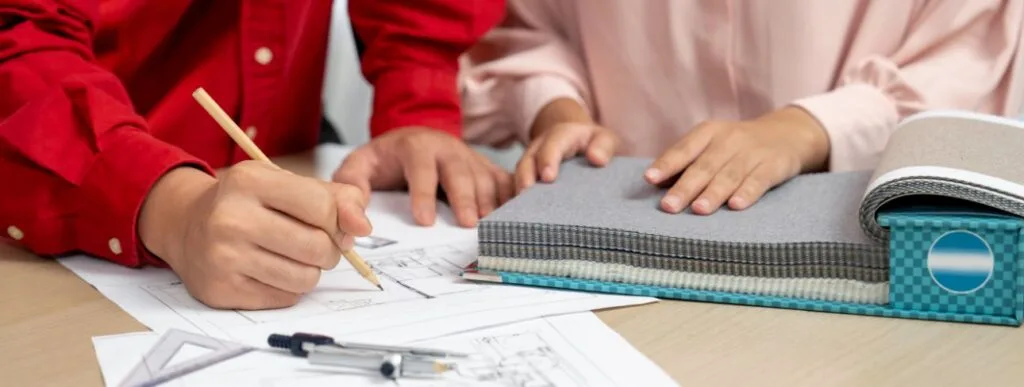
Understanding polyester’s strengths and limitations helps consumers and manufacturers make informed decisions about fabric selection. While polyester offers numerous practical advantages, it also presents certain challenges that may influence its suitability for specific applications.
Comprehensive Advantages
- Exceptional Durability stands as polyester’s most significant advantage. The synthetic fiber can withstand extensive use without showing signs of wear that would quickly affect natural fibers. Garments maintain their appearance and structural integrity through hundreds of wash cycles, making polyester excellent value for money over time.
- Low Maintenance Requirements make polyester particularly appealing for busy lifestyles. The fabric requires minimal ironing, resists staining, and can be machine washed and dried without special care. This convenience factor has made polyester indispensable for travel clothing, children’s wear, and everyday garments.
- Cost Effectiveness enables affordable clothing production and accessibility. Polyester’s synthetic nature allows for consistent, large-scale production at lower costs than natural fibers. This affordability makes quality clothing accessible to broader consumer segments while enabling businesses to maintain competitive pricing.
- Color Retention ensures garments maintain their appearance over extended periods. Polyester’s low moisture absorption prevents dyes from bleeding or fading during washing. Colors remain vibrant even after repeated exposure to sunlight and cleaning chemicals, maintaining the original aesthetic appeal.
- Weather Resistance makes polyester valuable for outdoor applications. The fiber performs well in various climatic conditions, resisting damage from UV radiation, moisture, and temperature fluctuations. This reliability makes polyester essential for outdoor gear, awnings, and protective covers.
- Shape Retention prevents garments from stretching, sagging, or losing their fit over time. Professional attire maintains its silhouette throughout long workdays, and casual clothing continues fitting properly after repeated wear and washing.
Notable Disadvantages
- Limited Breathability represents polyester’s most commonly cited drawback. The synthetic fiber’s low moisture absorption can trap heat and humidity against the skin, creating discomfort during physical activity or in warm conditions. This characteristic makes pure polyester less suitable for intimate apparel or summer clothing.
- Static Electricity Generation creates practical problems including lint attraction and uncomfortable clinging. Dry conditions exacerbate this issue, making garments stick to the body or other surfaces. Static buildup can be particularly problematic in environments sensitive to electrical discharge.
- Environmental Impact raises significant sustainability concerns. Traditional polyester production relies on non-renewable petroleum resources and generates greenhouse gases. The material’s non-biodegradable nature means it persists in landfills for hundreds of years, contributing to long-term environmental challenges.
- Texture Limitations affect comfort and aesthetic appeal. Lower-grade polyester can feel rough or synthetic against the skin, lacking the natural softness of cotton or the luxury feel of silk. This texture difference is particularly noticeable in direct-contact applications like underwear or bedding.
- Heat Sensitivity requires careful handling during cleaning and maintenance. Excessive heat can cause permanent damage, melting, or deformation. Iron settings must be carefully controlled, and high-temperature drying should be avoided to prevent fabric damage.
- Odor Retention can develop with extended wear, particularly during physical activity. Polyester’s synthetic nature and low breathability can trap odors that become difficult to remove with standard washing. This characteristic makes polyester challenging for athletic wear without antimicrobial treatments.
Performance Comparison Matrix
| Characteristic | Polyester | Cotton | Wool | Silk |
|---|---|---|---|---|
| Durability | Excellent | Good | Good | Fair |
| Maintenance | Very Easy | Moderate | Difficult | Difficult |
| Breathability | Poor | Excellent | Good | Excellent |
| Moisture Absorption | Very Low | High | High | Moderate |
| Static Resistance | Poor | Good | Fair | Fair |
| Shape Retention | Excellent | Fair | Good | Fair |
| Cost | Low | Moderate | High | Very High |
| Environmental Impact | Poor | Moderate | Good | Good |
Care and Maintenance of Polyester Fabric

Proper care significantly extends polyester fabric life while maintaining appearance and performance characteristics. Understanding appropriate cleaning methods and maintenance techniques helps maximize the investment in polyester textiles while preventing common care-related problems.
Optimal Washing Procedures
- Temperature Selection plays a crucial role in polyester care. Cold water washing (30°C or below) provides optimal results for most polyester garments, preserving colors and preventing fiber damage. Warm water (40°C) can be used for heavily soiled items, but hot water should be avoided to prevent heat damage and color fading.
- Detergent Choice affects cleaning effectiveness and fabric longevity. Mild, liquid detergents work best for polyester, avoiding harsh chemicals that can break down synthetic fibers over time. Powder detergents may not dissolve completely in cold water, potentially leaving residue on fabric surfaces.
- Washing Machine Settings should accommodate polyester’s synthetic nature. Normal or permanent press cycles provide appropriate agitation and spin speeds for most polyester items. Delicate cycles work well for lightweight or heavily embellished polyester garments that require gentler handling.
- Load Management prevents excessive wear and static buildup. Washing similar fabrics together reduces friction and static generation. Separating colors prevents dye transfer, particularly important for new polyester garments that may release excess dye during initial washes.
Effective Drying Techniques
- Heat Control during drying is essential for maintaining polyester integrity. Low heat settings (60°C or below) prevent fiber damage while providing adequate drying. High heat can cause permanent wrinkling, shrinkage, or melting, particularly problematic for blended fabrics containing polyester.
- Timing Considerations help minimize wrinkles and static buildup. Removing garments while slightly damp allows residual heat to complete drying while preventing over-drying that increases static electricity. Prompt removal from the dryer prevents wrinkles from setting permanently.
- Air Drying provides the gentlest drying method for delicate or heavily structured polyester garments. Hanging or laying flat preserves shape while eliminating heat-related damage risks. Air drying also reduces energy consumption and extends fabric life significantly.
- Fabric Softener Use can improve polyester hand feel and reduce static buildup. However, excessive use may reduce moisture-wicking properties in performance fabrics. Dryer sheets provide similar benefits with less residue buildup than liquid softeners.
Professional Cleaning Considerations
- Dry Cleaning may be necessary for structured garments, heavy fabrics, or items with special finishes. Professional cleaning preserves shape and appearance while handling items that cannot withstand home washing. However, frequent dry cleaning can be expensive and may affect certain polyester treatments.
- Stain Treatment requires prompt attention for best results. Most stains can be removed from polyester using appropriate spot treatments before washing. Oil-based stains may require pre-treatment with dish soap, while protein stains respond well to enzyme-based cleaners.
- Special Finishes may require modified care procedures. Water-repellent treatments need specific detergents to maintain effectiveness. Flame-retardant finishes may have washing restrictions to preserve safety properties. Always check care labels for specific requirements.
Storage and Maintenance
- Proper Storage prevents damage during non-use periods. Clean garments before storage to prevent stains from setting permanently. Adequate ventilation prevents musty odors, while protection from direct sunlight prevents UV damage and color fading.
- Wrinkle Prevention can be achieved through proper hanging and folding techniques. Structured garments benefit from padded hangers that maintain shape. Folded items should be stored with minimal weight on top to prevent permanent creasing.
- Repair and Maintenance can extend polyester fabric life significantly. Small tears or loose seams should be addressed promptly to prevent further damage. Professional alterations work well with polyester due to its stable nature and heat-setting capabilities.
Troubleshooting Common Issues
- Static Reduction can be achieved through several methods. Fabric softeners, anti-static sprays, or dryer sheets help manage static buildup. Maintaining proper humidity levels in living spaces also reduces static generation during wear.
- Odor Management requires attention to washing frequency and techniques. Pre-treating heavily soiled areas, using adequate detergent amounts, and ensuring complete rinsing help prevent odor retention. Antimicrobial treatments may be beneficial for activewear or frequently worn items.
- Color Restoration may be possible for faded polyester items. Cold water washing with color-safe bleach can help brighten colors. However, prevention through proper care provides better long-term results than attempting restoration.
Environmental Impact and Sustainability
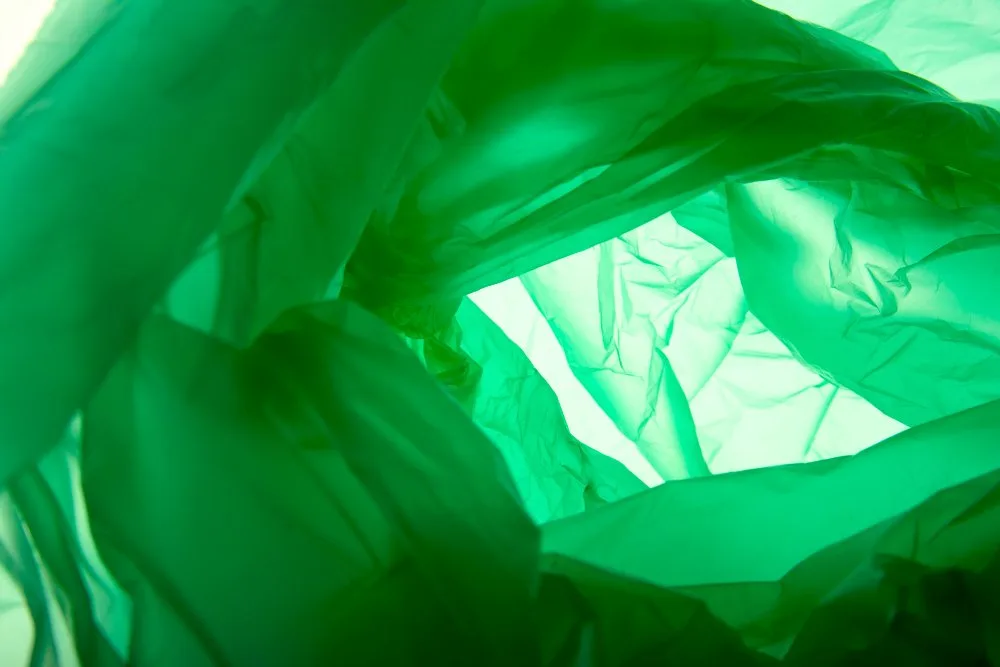
The environmental implications of polyester production and use have become increasingly important considerations for consumers, manufacturers, and policymakers. Understanding these impacts helps inform decisions about fabric selection and disposal while highlighting areas for improvement in polyester sustainability.
Production Environmental Costs
- Fossil Fuel Dependency represents polyester’s most significant environmental challenge. Traditional polyester production relies entirely on petroleum-based feedstocks, contributing to fossil fuel consumption and associated carbon emissions. The production of one kilogram of polyester generates approximately 9.52 kg of CO2 equivalent, significantly higher than natural fiber alternatives.
- Energy Consumption during polyester manufacturing exceeds that of most natural fibers. The high-temperature processes required for polymerization and spinning consume substantial amounts of energy, typically from non-renewable sources. Manufacturing one ton of polyester requires approximately 125 GJ (gigajoules) of energy, compared to 55 GJ for cotton production.
- Water Usage in polyester production varies significantly by manufacturing process but generally requires less water than natural fiber production. However, the water used often becomes contaminated with chemicals requiring extensive treatment before safe discharge. Additionally, microfiber pollution from polyester washing creates ongoing water contamination issues.
- Chemical Emissions during production include various volatile organic compounds (VOCs) and potential toxic substances. Manufacturing facilities must implement sophisticated emission control systems to prevent air and water pollution. The use of antimony trioxide as a catalyst in PET production raises particular environmental and health concerns.
Microplastic Pollution Crisis
Washing-Related Microfiber Release represents an emerging environmental crisis linked to synthetic textiles. Each wash cycle releases thousands of microscopic polyester fibers into wastewater systems. Research indicates that a single polyester garment can release up to 1,900 microfibers per wash, with front-loading machines generally releasing fewer fibers than top-loading alternatives.
These microplastics pass through most wastewater treatment facilities unchanged, eventually reaching rivers, lakes, and oceans. Marine life ingests these particles, potentially introducing plastic contamination into food chains. The long-term ecological impacts of microplastic accumulation remain under investigation, but early research suggests significant environmental concerns.
Mitigation Strategies for microfiber pollution include using washing bags like Guppyfriend, which capture released fibers during washing. Cold water washing, shorter wash cycles, and full loads reduce microfiber release. Some manufacturers now produce polyester fabrics with modified fiber structures that shed fewer microparticles.
End-of-Life Challenges
- Biodegradability Limitations mean polyester fabrics persist in landfills for 200-500 years without significant decomposition. Unlike natural fibers that return nutrients to soil systems, polyester creates long-term waste accumulation. This persistence contributes to growing textile waste problems in developed and developing nations.
- Incineration Impacts occur when polyester waste is burned for energy recovery. While this process eliminates landfill accumulation, it releases carbon dioxide and potentially toxic compounds into the atmosphere. Proper emission controls are essential to minimize environmental impacts from polyester incineration.
- Landfill Accumulation continues growing as fast fashion increases polyester consumption. The Ellen MacArthur Foundation estimates that less than 1% of clothing materials are recycled into new clothing, with most polyester garments ultimately reaching landfills after brief use periods.
Recycling and Circular Economy Solutions
Mechanical Recycling processes convert used polyester products into new fibers through physical breakdown and reprocessing. Post-consumer PET bottles represent the largest source of recycled polyester feedstock, with over 35 billion bottles converted annually into textile fibers. This process reduces petroleum consumption while diverting waste from landfills.
The quality of mechanically recycled polyester approaches that of virgin fibers, making it suitable for most textile applications. However, each recycling cycle slightly degrades fiber properties, limiting the number of times material can be recycled. Typical recycled polyester maintains 85-95% of virgin fiber strength and performance characteristics.
Chemical Recycling represents an advanced approach that breaks polyester down to its molecular components for reconstruction into new polymers. This process can handle mixed textile waste and potentially provides unlimited recycling cycles without quality degradation. Several companies are developing commercial-scale chemical recycling facilities specifically for polyester textiles.
Textile-to-Textile Recycling initiatives focus specifically on converting polyester clothing waste into new textile fibers. Programs like Unifi’s Textile Takeback collect fabric waste from manufacturers and consumers, processing it into REPREVE recycled fibers. These closed-loop systems reduce reliance on bottle waste while addressing textile-specific recycling needs.
Sustainability Initiatives and Progress
- Industry Commitments increasingly focus on sustainable polyester production and use. The 2025 Recycled Polyester Challenge, supported by Textile Exchange and the UN Framework Convention on Climate Change, calls for companies to source 45-100% of their polyester from recycled sources by 2025. Over 160 companies have committed to this target, representing significant market transformation.
- Bio-Based Alternatives offer potential solutions to polyester’s fossil fuel dependency. Companies like NatureWorks produce polyester from renewable plant sources, while others explore algae-based feedstocks. These alternatives can reduce carbon footprints by 25-75% compared to petroleum-based polyester, though production costs remain higher.
- Innovation in Manufacturing includes developments in lower-energy production processes, renewable energy adoption, and waste reduction initiatives. Some manufacturers now operate carbon-neutral facilities powered by renewable energy sources. Advanced catalyst systems reduce energy requirements while eliminating harmful chemical emissions.
- Consumer Education programs help individuals make informed decisions about polyester use and care. Proper care extends garment life, reducing overall environmental impact. Supporting brands with strong sustainability commitments encourages industry-wide improvements in polyester production and use practices.
Industry Market Analysis and Future Trends

The polyester industry continues evolving rapidly, driven by technological innovations, sustainability pressures, and changing consumer preferences. Understanding current market dynamics and emerging trends helps predict future developments in polyester production and applications.
Current Market Landscape
The global polyester fiber market reached $109.57 billion in 2025, with projections indicating growth to $157.38 billion by 2030. This represents a robust 7.5% compound annual growth rate, reflecting continued demand across textile and industrial applications. Asia-Pacific dominates production, accounting for over 60% of global capacity, with China leading manufacturing output.
Regional Production Distribution shows significant geographic concentration in Asia. China produces approximately 60% of global polyester fiber, followed by India with 12%, and other Asian countries contributing another 15%. This concentration creates supply chain vulnerabilities but also enables efficient large-scale production and cost optimization.
Application Segment Growth varies across different end uses. Apparel remains the largest segment at 65% of total consumption, followed by home textiles at 20%, and industrial applications at 15%. Technical textiles represent the fastest-growing segment, driven by automotive, construction, and filtration applications requiring specialized performance characteristics.
Technological Innovations
- Advanced Fiber Engineering continues pushing polyester performance boundaries. New fiber cross-sections improve moisture management and hand feel while maintaining durability advantages. Hollow fibers provide enhanced insulation properties, while multi-lobal shapes create silk-like aesthetics and improved dye uptake characteristics.
- Smart Textile Integration incorporates electronic components and responsive materials into polyester fabrics. Phase-change materials regulate body temperature, while conductive fibers enable electronic functionality. These innovations expand polyester applications into healthcare monitoring, sports performance, and protective equipment markets.
- Nanotechnology Applications enhance polyester properties through molecular-level modifications. Nanoparticle treatments provide antimicrobial properties, UV protection, and self-cleaning capabilities. These treatments can be applied during fiber production or as post-processing finishes, offering flexibility in product development.
Sustainability Developments
- Bio-Based Polyester Advances show promising developments in renewable feedstock utilization. Companies are developing polyester from agricultural waste, algae, and other renewable sources. These alternatives can reduce carbon footprints by 30-70% compared to petroleum-based production while maintaining performance characteristics.
- Chemical Recycling Expansion represents a significant technological advancement for polyester sustainability. New depolymerization processes can convert mixed textile waste back to virgin-quality monomers for new polyester production. Several commercial-scale facilities are planned for operation by 2027, potentially revolutionizing textile recycling.
- Circular Economy Initiatives are transforming how polyester products are designed, used, and recycled. Design for recyclability principles influence new product development, while extended producer responsibility programs encourage manufacturers to consider end-of-life impacts. These initiatives are supported by regulatory developments in Europe and other regions.
Regulatory and Policy Impacts
- Environmental Regulations increasingly affect polyester production and use. The European Union’s textile strategy includes requirements for separate textile waste collection beginning in 2025, potentially increasing recycled polyester availability. Microplastic pollution regulations may mandate washing machine filters or fabric modifications to reduce fiber shedding.
- Sustainability Reporting Requirements demand greater transparency from polyester manufacturers and brands. Life cycle assessments, carbon footprint disclosures, and supply chain traceability become mandatory for many companies. These requirements drive investment in cleaner technologies and sustainable practices.
- Trade Policy Influences affect global polyester supply chains and pricing. Tariffs, trade agreements, and regional policies impact production location decisions and market access. The industry’s geographic concentration in Asia makes it particularly sensitive to international trade developments.
Future Outlook and Projections
- Demand Growth Drivers include population growth, rising disposable incomes in developing countries, and expanding technical textile applications. The shift toward athleisure and performance clothing continues driving polyester consumption. Industrial applications in automotive, construction, and filtration show strong growth potential.
- Technology Convergence will likely see polyester integrated with other advanced materials and technologies. Smart textiles, sustainable production methods, and enhanced performance characteristics will drive product differentiation. The integration of artificial intelligence in manufacturing processes will optimize production efficiency and quality control.
- Market Consolidation trends suggest larger companies will continue acquiring smaller players to achieve scale economies and technology access. Vertical integration along supply chains may increase as companies seek greater control over sustainability and quality. Strategic partnerships between traditional manufacturers and technology companies will accelerate innovation.
Conclusion
Polyester fabric has fundamentally transformed the global textile industry since its commercial introduction in the 1950s, evolving from a basic synthetic alternative to a sophisticated, engineered material essential to modern life. This comprehensive analysis reveals polyester’s complex nature as both an indispensable practical solution and a significant environmental challenge requiring urgent attention.
Performance and Practical Excellence
Polyester’s dominance in the $109.57 billion global fiber market reflects its exceptional combination of durability, versatility, and cost-effectiveness. The fabric’s tensile strength of 45,000-65,000 PSI surpasses most natural alternatives, while its dimensional stability and wrinkle resistance provide unmatched convenience for consumers and manufacturers alike. Quality grades ranging from basic commercial to premium performance specifications ensure polyester meets diverse application requirements from everyday clothing to specialized industrial uses.
The fabric’s technological sophistication continues advancing through innovations in fiber engineering, smart textile integration, and specialized treatments. Modern polyester can incorporate antimicrobial properties, moisture-wicking capabilities, flame resistance, and even electronic functionality. These developments position polyester as a platform for future textile innovations rather than simply a commodity material.
Environmental Challenges and Solutions
Polyester’s environmental impact represents one of the most pressing challenges facing the textile industry. The material’s petroleum dependency, microplastic pollution, and non-biodegradable nature create significant ecological concerns that demand immediate attention. Each polyester garment releases up to 1,900 microfibers per wash cycle, contributing to marine pollution and potential food chain contamination.
However, promising solutions are emerging through recycled polyester production, bio-based alternatives, and chemical recycling technologies. The 2025 Recycled Polyester Challenge has mobilized industry commitment to sourcing 45-100% recycled content, while innovative companies develop polyester from renewable feedstocks that can reduce carbon footprints by 30-70%. These initiatives demonstrate that polyester’s environmental impact can be substantially reduced through technological innovation and industry commitment.
Quality and Application Considerations
Understanding polyester quality variations empowers better decision-making for both consumers and professionals. Premium polyester grades offer comfort and aesthetics approaching natural fibers while maintaining synthetic advantages. The key lies in selecting appropriate quality levels and constructions for specific applications rather than dismissing polyester categorically.
Proper care and maintenance significantly extend polyester’s already impressive lifespan while maintaining performance characteristics. Cold water washing, low-heat drying, and appropriate storage prevent common problems while maximizing value. These practices also reduce environmental impact by extending garment life and reducing replacement frequency.
Strategic Recommendations
- For Consumers: Choose polyester thoughtfully based on specific needs and quality requirements. Invest in higher-quality polyester for frequently worn items where durability and appearance retention justify the cost. Support brands committed to sustainable polyester sourcing and consider recycled polyester options when available. Implement proper care practices to maximize garment lifespan and minimize environmental impact.
- For Manufacturers: Prioritize sustainable polyester sourcing and production methods to meet evolving consumer and regulatory expectations. Invest in quality improvements and specialized treatments that differentiate products while providing genuine consumer benefits. Develop take-back programs and circular economy initiatives that address end-of-life considerations.
- For Industry Stakeholders: Accelerate development and deployment of sustainable polyester technologies including bio-based feedstocks and chemical recycling. Support research into microplastic mitigation strategies and improved production processes. Collaborate on industry standards and certification programs that provide transparency and guide consumer choices.
Future Outlook
The polyester industry stands at a critical juncture where technological capability and environmental responsibility must converge. Projected growth to $157.38 billion by 2030 offers opportunities to implement sustainable practices at scale while meeting global textile needs. Success requires balancing polyester’s practical advantages with environmental stewardship through innovation, regulation, and consumer education.
Emerging technologies like chemical recycling, bio-based production, and smart textile integration promise to address current limitations while expanding polyester’s capabilities. The industry’s geographic concentration in Asia positions these regions as leaders in sustainable transformation, with potential global implications for environmental impact and supply chain resilience.
Polyester’s future depends on the industry’s ability to maintain the material’s practical advantages while dramatically reducing its environmental footprint. This transformation is not only possible but essential for sustainable textile production. Through continued innovation, responsible manufacturing, and informed consumer choices, polyester can evolve from an environmental challenge into a model of sustainable synthetic material production.
The complete picture of polyester fabric reveals a material of remarkable utility and concerning environmental impact. Understanding these complexities enables better decisions that harness polyester’s benefits while supporting necessary improvements in sustainability and environmental responsibility. The future of polyester lies not in replacement but in responsible evolution toward truly sustainable synthetic fiber production.
Frequently Asked Questions
Is polyester a good quality fabric?
Polyester quality varies significantly depending on the grade and manufacturing process. Premium polyester can offer excellent performance characteristics including durability, color retention, and easy care. The fabric’s quality depends on factors like fiber fineness, weaving density, and finishing treatments. High-quality polyester can rival natural fibers in many applications while offering superior performance in others.
Which is better: cotton or polyester?
The choice between cotton and polyester depends on specific needs and priorities. Cotton excels in breathability, natural feel, and environmental sustainability, making it better for undergarments, summer clothing, and direct skin contact. Polyester surpasses cotton in durability, wrinkle resistance, and moisture-wicking properties, making it superior for activewear, outdoor gear, and low-maintenance clothing.
What does polyester feel like?
Polyester texture varies considerably across different grades and constructions. Basic polyester can feel synthetic, smooth, and sometimes slippery or rough. Premium polyester, particularly microfiber varieties, can feel soft and silky, closely mimicking natural fiber textures. The hand feel also depends on fabric construction, with knitted polyester generally feeling softer than woven alternatives.
Is polyester cheap quality?
Polyester spans a wide quality range from budget to premium grades. While polyester enables affordable clothing production, this doesn’t automatically indicate poor quality. The association with “cheap” comes from the prevalence of low-grade polyester in fast fashion. High-quality polyester used in performance wear, luxury brands, and technical applications can be quite expensive and offer superior performance.
Does polyester shrink?
Polyester exhibits minimal shrinkage compared to natural fibers. Quality polyester typically shrinks less than 2-3% even under adverse conditions like hot water washing or high-heat drying. However, excessive heat can cause permanent deformation or melting rather than traditional shrinkage. Polyester blends may shrink more due to the natural fiber components.
Is polyester stretchy?
Pure polyester has limited stretch properties, typically offering only 10-15% elongation before breaking. However, polyester becomes stretchy when blended with elastane, spandex, or lycra. The fabric construction also affects stretch, with knitted polyester providing more give than woven alternatives. Stretch polyester fabrics can offer 20-40% stretch while maintaining recovery properties.
Is 100% polyester good for summer?
Pure polyester presents mixed benefits for summer wear. The fabric’s moisture-wicking properties and quick-drying characteristics can help manage perspiration. However, polyester’s limited breathability can trap heat against the skin, potentially causing discomfort. Lightweight, loosely woven polyester fabrics perform better in hot weather than heavy or tightly constructed alternatives.
Is 100% polyester good for winter?
Polyester can provide good insulation for winter wear, particularly in fleece or pile constructions that trap air for warmth. The fabric’s wind resistance and moisture management help maintain comfort in cold conditions. Layering systems often incorporate polyester base layers for moisture-wicking combined with insulating mid-layers for warmth retention.
Why do people avoid polyester?
Common concerns about polyester include environmental impact, comfort issues, and aesthetic preferences. The fabric’s petroleum-based origins and non-biodegradable nature concern environmentally conscious consumers. Comfort issues arise from static generation, limited breathability, and sometimes rough texture. Some people prefer natural fibers for their traditional aesthetic and perceived quality.
How bad is 100% polyester for the environment?
Pure polyester has significant environmental impacts including fossil fuel consumption, energy-intensive production, and microplastic pollution. However, recycled polyester reduces these impacts by 30-50% compared to virgin production. The environmental impact also depends on garment longevity, with durable polyester items having lower per-wear impacts than frequently replaced alternatives.
Are there different grades of polyester?
Yes, polyester quality varies significantly across commercial, premium, and performance grades. Commercial grade offers basic properties at low cost, premium grade provides enhanced comfort and appearance, and performance grade incorporates specialized characteristics like antimicrobial properties or flame resistance. Manufacturing differences, fiber fineness, and finishing treatments all contribute to quality variations.

